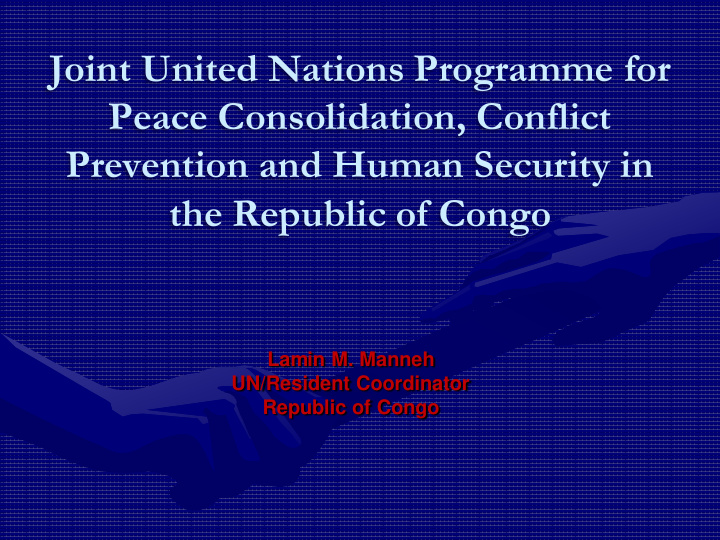



Joint United Nations Programme for Peace Consolidation, Conflict Prevention and Human Security in the Republic of Congo Lamin M. Manneh UN/Resident Coordinator Republic of Congo
Post-conflict situation Poverty indicators remain concerning at the grassroots level: The Human Development Index in 1980 was 0.462, in 2005, 0.470 and reached 0.489 in 2010, in 2011 ranks the Republic of Congo as 137 out of 183 countries; Income per capita in Congo has declined significantly and poverty has worsened since the conflict began; Food security is a daily challenge and children are no longer able to attend school regularly as they now have to fetch water or sell items at the local markets; Access to clean drinking water and sanitation facilities is extremely limited in many communities and in schools; Life expectancy has declined sharply and is 51.6, the unemployment rate in Brazzaville 17.6% as per the UNDP’s country office report 2010; The death rate of children under 5 years is 110/1000 and the maternal death rate has remained at 781/100000. Gender-based violence is commonplace in most areas and particularly in the Pool region.
Responses background Initial peace-building and DDR initiatives were based on separate projects conducted by the government, UN agencies and other partners IOM in 2001/2002; PDR undertaken in 2002/2004; Special Programme for the Pool region; National programme for disarmament Demobilisation and Reintegration PNDDR; UNDP’s project for the collection of arms for development (PCAD I and II); UNDP’s project for the reintegration of youths at risk (PRESJAR I and II). As indicated above there was no integrated or joint programme to support DDR, peace-building or conflict prevention initiatives. 3
4
Initial Project activities The reinforcement of gender and HIV/AIDS dimensions in the project document with the support of the Interagency working group on DDR and BCPR; Establishment of the an interagency working group; Updated inter-agency annual work plan; Recruitment of consultants to support agencies to conduct the identificiation of beneficiaries coupled with an underlying survey; Initial evaluation mission on the ground to identify the project sites and assessment economic reintegration opportunities. 5
• Initial grassroots activities Mobilization, sensitization and training sessions of the project beneficiaries in Mayama in the target province of Pool. 6
Initial project beneficiaries identified Reintegration Districts within Mayama in the Number of beneficiaries opportunities Pool region Youths at risk women Ex-combatants or vulnerable people district 1 Matsoua 0 o 1 district 2 Bitelomono 4 2 1 district 3 Loutini 4 4 3 gardening district 4 Mienanzambi 0 4 0 Sub-total 8 10 5 district 1 Matsoua 11 2 1 district 2 Bitelomono 0 2 2 Pig breeding district 3 Loutini 6 2 1 district 4 Mienanzambi 7 5 0 Sub-total 24 11 4 district 1 Matsoua 10 4 0 district 2 Bitelomono 4 13 2 Poultry farming district 3 Loutini 3 14 3 district 4 Mienanzambi 1 1 0 Sub-total 18 32 5 district 1 Matsoua 9 9 1 district 2 Bitelomono 0 0 3 Fish farming district 3 Loutini 2 16 1 district 4 Mienanzambi 0 0 0 Sub-total 11 25 5 Total in each group 61 78 19 Total number of beneficiaries 158
Initial concrete activities Preparation of the sites for the implementation of concrete income generating activities in Mayama, Pool region.
Thank you
Recommend
More recommend